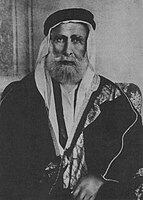Banu Qatadah: Difference between revisions
No edit summary Tag: Reverted |
No edit summary Tag: Reverted |
||
| Line 14: | Line 14: | ||
| religion = [[Islam]] |
| religion = [[Islam]] |
||
}} |
}} |
||
The '''Banu Qatadah''' ({{lang-ar|بنو قتادة|Banū Qatādah|Sons of Qatadah}}), or the '''Qatadids''' ({{lang-ar|القتاديون|al-Qatādayūn}}), were a dynasty of [[Hasanid]] [[sharif]]s that held the [[Sharifate of Mecca]] continuously from 1201 until its abolition in 1925. The Qatadids were the last of four dynasties of Hasanid sharifs (preceded by the Jafarids/Musawids, [[Sulaymanids]], and the Hawashim) that all together ruled [[Mecca]] since about the mid-10th century. The progenitor of the dynasty was [[Qatadah ibn Idris]], who took possession of the holy city from the elder Hawashim in 1201. The Emirate remained in the possession of his descendants until 1925 when the last Sharif of Mecca, [[Ali of Hejaz|Ali ibn al-Husayn]], surrendered the [[Kingdom of Hejaz]] to [[Ibn Saud]], [[Sultanate of Nejd|Sultan of Nejd]].<ref>{{EI2 |title=Hashimids |volume=3 |pages=262–263}}</ref><ref>{{EI2 |title=Makka |volume=6 |pages=149–151}}</ref> The [[House of Bolkiah]], which rules [[Brunei]], claims Qatadid descent and [[Sayyid]] status from their ancestor [[Sharif Ali]]'s |
The '''Banu Qatadah''' ({{lang-ar|بنو قتادة|Banū Qatādah|Sons of Qatadah}}), or the '''Qatadids''' ({{lang-ar|القتاديون|al-Qatādayūn}}), were a dynasty of [[Hasanid]] [[sharif]]s that held the [[Sharifate of Mecca]] continuously from 1201 until its abolition in 1925. The Qatadids were the last of four dynasties of Hasanid sharifs (preceded by the Jafarids/Musawids, [[Sulaymanids]], and the Hawashim) that all together ruled [[Mecca]] since about the mid-10th century. The progenitor of the dynasty was [[Qatadah ibn Idris]], who took possession of the holy city from the elder Hawashim in 1201. The Emirate remained in the possession of his descendants until 1925 when the last Sharif of Mecca, [[Ali of Hejaz|Ali ibn al-Husayn]], surrendered the [[Kingdom of Hejaz]] to [[Ibn Saud]], [[Sultanate of Nejd|Sultan of Nejd]].<ref>{{EI2 |title=Hashimids |volume=3 |pages=262–263}}</ref><ref>{{EI2 |title=Makka |volume=6 |pages=149–151}}</ref> The [[House of Bolkiah]], which rules [[Brunei]], claims Qatadid descent and [[Sayyid]] status from their ancestor [[Sharif Ali]]'s father emir [[Ajlan ibn Rumaythah]]. |
||
<gallery widths="200px" heights="200px"> |
<gallery widths="200px" heights="200px"> |
||
Revision as of 23:36, 3 July 2024
| Banu Qatadah بنو قتادة | |
|---|---|
| Hassanid Arab tribe | |
 Banner of the Sharifate of Mecca | |
| Descended from | Qatadah ibn Idris ibn Mutaan ibn Abd al-Karim ibn Issa ibn Hussein ibn Suleiman ibn Ali ibn Abd Allah ibn Muhammad ibn Musa ibn Abd Allah ibn Musa ibn Abd Allah ibn Hassan II ibn Hassan ibn Ali ibn Abu Talib |
| Religion | Islam |
The Banu Qatadah (Arabic: بنو قتادة, romanized: Banū Qatādah, lit. 'Sons of Qatadah'), or the Qatadids (Arabic: القتاديون, romanized: al-Qatādayūn), were a dynasty of Hasanid sharifs that held the Sharifate of Mecca continuously from 1201 until its abolition in 1925. The Qatadids were the last of four dynasties of Hasanid sharifs (preceded by the Jafarids/Musawids, Sulaymanids, and the Hawashim) that all together ruled Mecca since about the mid-10th century. The progenitor of the dynasty was Qatadah ibn Idris, who took possession of the holy city from the elder Hawashim in 1201. The Emirate remained in the possession of his descendants until 1925 when the last Sharif of Mecca, Ali ibn al-Husayn, surrendered the Kingdom of Hejaz to Ibn Saud, Sultan of Nejd.[1][2] The House of Bolkiah, which rules Brunei, claims Qatadid descent and Sayyid status from their ancestor Sharif Ali's father emir Ajlan ibn Rumaythah.
-
Hussein bin Ali, Sharif of Mecca (1853–1931), the founder of the modern dynasty
-
King Faisal I of Iraq and King Ali of Hejaz
-
Banu Qatada ancestors and ruling line, king Qatada in the middle
See also
References
- ^ Lewis, B.; Ménage, V. L.; Pellat, Ch. & Schacht, J., eds. (1971). "Hashimids". The Encyclopaedia of Islam, Second Edition. Volume III: H–Iram. Leiden: E. J. Brill. pp. 262–263. OCLC 495469525.
- ^ Bosworth, C. E.; van Donzel, E. & Pellat, Ch., eds. (1991). "Makka". The Encyclopaedia of Islam, Second Edition. Volume VI: Mahk–Mid. Leiden: E. J. Brill. pp. 149–151. ISBN 978-90-04-08112-3.



